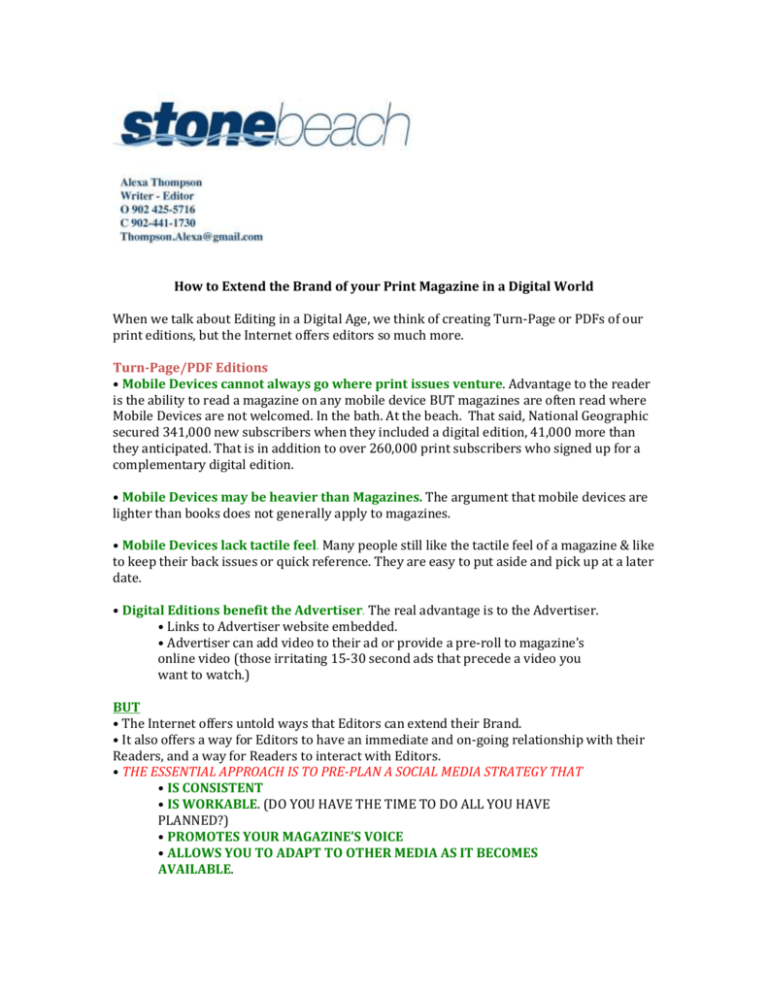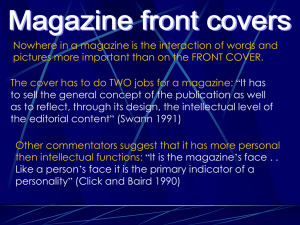Print Magazines in a Digital World
advertisement

How to Extend the Brand of your Print Magazine in a Digital World When we talk about Editing in a Digital Age, we think of creating Turn-Page or PDFs of our print editions, but the Internet offers editors so much more. Turn-Page/PDF Editions • Mobile Devices cannot always go where print issues venture. Advantage to the reader is the ability to read a magazine on any mobile device BUT magazines are often read where Mobile Devices are not welcomed. In the bath. At the beach. That said, National Geographic secured 341,000 new subscribers when they included a digital edition, 41,000 more than they anticipated. That is in addition to over 260,000 print subscribers who signed up for a complementary digital edition. • Mobile Devices may be heavier than Magazines. The argument that mobile devices are lighter than books does not generally apply to magazines. • Mobile Devices lack tactile feel. Many people still like the tactile feel of a magazine & like to keep their back issues or quick reference. They are easy to put aside and pick up at a later date. • Digital Editions benefit the Advertiser. The real advantage is to the Advertiser. • Links to Advertiser website embedded. • Advertiser can add video to their ad or provide a pre-roll to magazine’s online video (those irritating 15-30 second ads that precede a video you want to watch.) BUT • The Internet offers untold ways that Editors can extend their Brand. • It also offers a way for Editors to have an immediate and on-going relationship with their Readers, and a way for Readers to interact with Editors. • THE ESSENTIAL APPROACH IS TO PRE-PLAN A SOCIAL MEDIA STRATEGY THAT • IS CONSISTENT • IS WORKABLE. (DO YOU HAVE THE TIME TO DO ALL YOU HAVE PLANNED?) • PROMOTES YOUR MAGAZINE’S VOICE • ALLOWS YOU TO ADAPT TO OTHER MEDIA AS IT BECOMES AVAILABLE. HOW? Enhance readers’ experience with: 1. New Content • Fresh Content. Fresh, new content can be added at any time. It can be current news. It can provide more information on a story in your print edition. It can be an interview with the writer of an article. Or a reading by the author of a book reviewed in your print edition. • Timely. You can be timely online. (Example of cover story I did on a Cape Breton musician who was breaking into the international scene. The day the magazine was published, he regrettably died. The digital world offered me a chance to write an obituary and mark his passing without having to wait until 3 months for the next issue to be printed. It also allowed me to explain why the article was written in the present with no mention of his passing.) 2. A Look Behind the Scenes • How a story develops. • What it’s like to be on a photo shoot. (Example of a Food Recipe in the magazine. How the food is cooked, tasted, lit, styled & photographed) • Interview with the Writer — readers like to know the creative process, how the idea was pitched, etc. • Live interview with the subject of an article so the reader feels a part of the interview process and not just the end consumer of an article. • Additional Material. When you reduce a 2000 word article to 750 words, a lot is lost. That material can be rebranded online. 3. Long Form Writing • Most Shared: The articles most shared among Internet users are long form articles (2000 plus words) that are meaty and present a unique perspective. These articles in their entirety are often too long for print, where the number of pages is an issue. When articles are shared, you’ve no idea how far and wide they are being stretched. But a shared article will bring more traffic to your website and, hopefully, your subscriber base. • Increase Brand Awareness: Shared articles increase your brand awareness and may lead to new subscribers. • Complement Print Articles: Long Form Writing can complement a shorter piece in print. 4. Reader Comments — A Way to Enhance the Readers’ Experience • Immediate: Readers can comment immediately on online material and engage each other in dialogue. They can also interact with the Editor, not dissimilar to feeling you’ve connected with a pop star online. • New Story Ideas: Readers can suggest story ideas. • Potential Experts/Writers: You may be able to identify experts and/or potential writers from among your commenters. • Weed the commentators from the trolls: Trolls just like to read their words and irritate. Their comments are meant to provoke but not in a positive way. They may deliberately take a counter point-of-view, even when their perspective makes no sense. You’ll recognize a troll. They are the ones who have a negative statement even if the story is about the rescue of a baby. Trolls can be deleted before their voice is heard if your comments are moderated. However this is not only time-consuming but can be seen as censorship. Best option is to leave trolls be. Your other commentators will round on them and eventually they will go away. 5. Photo 101: The Internet is a Visual World • Editors & Writers who use cameras with short video capabilities are better prepared to use the Digital World to complement their print issue. • No one expects these individuals to produce professional photographs but any images uploaded to a Website, Blog, Instagram, Facebook or Twitter, etc., need to be of the best quality available. Don’t upload rubbish. It reflects negatively on your brand. Save the blurry images for your personal Facebook page. • Today’s cameras are so sophisticated yet easy to use that it is almost impossible to take a truly “bad” photo. 6. Getting the Most out of Social Media to Enhance the Readers’ Experience • Twitter: Learn to write about what your magazine is doing in under 140 characters. Stories your writers are working on. Tease about the next issue without scooping yourself. (Update daily) [Twitter can be addictive. I was listening to a speaker on the topic of Twitter who was speaking in short, staccato sentences, and I realized he was speaking in Twitter-eze.] • Facebook: Set up a professional page that allows for more than 5000 “friends” to talk about what’s going on in the Editorial Room. (At least every 2nd day) • Instagram: a great place to upload photos of “Behind the Scenes”, such as an Editorial meeting in process. You can also upload photos of your next big spread, but be careful not to scoop yourself. (Weekly) • You Tube: Where you can store videos from interviews, etc. When I used to interview Celtic bands, I’d see if I could get the group to do an impromptu 30-second jam session for our You Tube channel. You Tube is where your readers want to be online. After Google it is the Internet’s most used search engine. Readers want the visual stimulation. It’s the theory behind the Chicago Sun Times decision to fire their Photo Department and send their reporters out with stills cameras capable of taking video. • Pinterest. If your magazine includes home decorating or recipes, Pinterest can be a place to store relevant material not used in the print magazine. 7. Editor’s Blogs Treat blogs like editorial copy. They should be well written, structured and typo-free. You are presenting your magazine’s brand with your blog. • Your Voice. Good Blogs are sharp, focused, witty, intelligent and present a “voice” that is unique. They are not impartial. There must be a point to a blog. It is not daily ramblings. (Swallowdaily.com is a great blog site, kept by a witty and forceful former cook and cookbook writer who is writing for those in the food industry, not lay folks. She taps into things like, the 10 worst dinners I ever had and invites chefs to comment. Michael Smith, from PEI, mentioned that being asked to eat regurgitated insects by tribes in the Amazon was his worst while another chef got into the business because her friend’s mother used to make spaghetti with a can of tomato soup, plastic cheese and Spam.) • Current. Blogs keep Readers up-to-date with the daily workings of your publication. There is an issue here. You have to tread a careful line. If you are talking about a story you are working on, tease it, certainly but don’t give your competitors too much information. You can be sure they are reading your blogs. • Immediate Responses. Blogs offer Editors a chance to respond immediately to the latest news and what it means to readers — especially useful if you’re a bi-monthly or quarterly. Stuff happens all the time. Your job as a blogger is to write about it, comment on it and put it into context for the reader. • Upcoming Stories. Blogs allow readers to comment on upcoming stories. (Don’t scoop yourself.) • Communications. Blogs let Editors and Readers communicate. • Shared. Good Blogs are shared far-and-wide and can bring you new subscribers, advertisers, writers and story ideas. • Blogs beget Blogs. There are others out there with similar interests writing blogs. You may pick up new bloggers to augment your own efforts and take off some of the pressure of producing your blog on a semi-weekly basis. • Vital. Blogs are vital for niche and special interest magazines whose readers may be widely spread demographically. It’s a way to create a community voice. If you are a Welsh immigrant in Patagonia, a blog by the editor of a magazine on Wales keeps you in touch with your heritage. • Bloggers usually work for the love of it but it is nice to offer an honorarium and, if not, at least free tickets to local events related to your publication. Conclusion • Online Editorial expands your magazine’s brand worldwide. • Online Editorial has no length restrictions. • Online Editorial complements print articles with additional information, videos and images — a “behind the scenes” look, etc. • Online Editorial engages readers & sparks immediate responses from them. • Online Editorial can attract new subscribers, new story ideas, new experts & new writers. • Online Editorial requires commitment if it is to be effective. • Budget your time! • Be aware whether your online presence is affecting your “real” job as editor of a print magazine. Is your online work cost affective in terms of revenue? Should you reduce your online presence or increase it? • Track your online successes: what works/what doesn’t work • Consider an intern to assist with your Online Editorial. In our digital world, work lines blur. The workday often doesn’t stop at 5. If you find you are finishing your blog at midnight, it’s time to get help.






